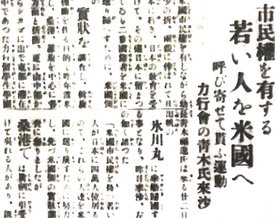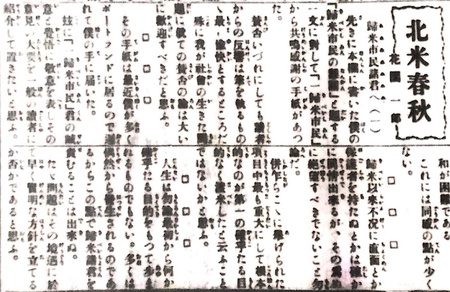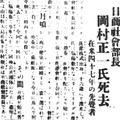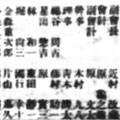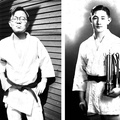In the last chapter I wrote about the JACL (Japanese American Citizens League) where Nisei became politically active and in this part I would like to feature the activities of the Kibei JACL which was established by Kibei Nisei.
Among Nisei were a group of people called Kibei Nikkei. Kibei Nikkei are the Japanese Americans who moved to Japan in their childhood and grew up there and re-entered the U.S. later in life. Many of them were “dual citizenship holders” who had the citizenship of both the U.S. and Japan which I wrote about in Chapter 13.
The future possibility of Kibei Nikkei was deemed highly important in Seattle around 1930; with Heiji Okuda and others being supporters, the Kibei JACL was established in 1932 in Seattle merging with Reimei-sha and Ginsei Club. At the time Kibei JACL had 120 to 130 members.
According to the 1936 edition of Hokubei Nenkan, the number of American-born Nisei in Seattle City was about 4,000 in 1934, so Kibei who were JACL members accounted for approximately 3% of Nisei in Seattle at the time.
Reality of Kibei Nisei
We can learn about the reality of Kibei Nikkei through a letter that a Kibei Nisei sent to the president of The North American Times, Sumiyoshi Arima. The letter was published in the December 15, 1939 issue of the North American Times. In the letter, a Kibei Nisei is described as “being controlled under peculiar circumstances” with the details as below:
“Hokubei Shunjyu — To Kibei Citizens” (December 15, 1939 issue1)
1. Many of them have re-entered the U.S. without any particular reason or have been forced to do so.
2. They have been facing an economic depression since the return.
3. Many have lost their parents.
4. Many don’t have responsible guardians.
5. With relatively little educational background, few are proficient enough in English.
6. They don’t have leaders who they can follow as a role model.
7. Cooperating with Nisei who grew up in the U.S. has been difficult.A good number of Issei who moved to the U.S. returned to Japan after they made some money. The children of these Issei parents had to move to Japan at a young age without having fully experienced American life.
Blocking and Supporting Kibei Nisei
There was an article reporting an attempt to prevent Nisei in Japan from returning to the U.S.
“Bill to Prevent Return of Nikkei” (October 21, 1935 issue)
It has been reported that a bill that could have a substantial impact on the return of Nisei citizens in Japan will be brought up at the upcoming congress. It has derived from an ongoing study by some congress people on the coast concerning a potential law that states ‘any American citizen either studying or living abroad will lose their citizenship if they don’t return to the U.S. within two years.’ . . . If this is to become a reality, it will surely have a significant effect on Kibei Nikkei and others.
Besides, this discussion is getting heated especially in California and its neighbors. As the attempt is said to be a counter proposal of California politicians against the Kibei Nikkei movement, the impact will no doubt be direct.
As a general rule, an American citizen’s passport is valid for two years; since the extension is permitted under certain circumstances, they might allow for some kind of extension. Some say that citizens might be exempt from having to return to the U.S. once every two years depending on how things get processed.
I found an article about the individual who encouraged and promoted the Kibei returning to the U.S.
“Calling Over Young Citizens to the U.S. – Aoki from Rikkokai, who Encourages Yobiyose, to Visit Seattle” (April 20, 1938 issue)
Last year, Mr. Aoki, the head of Rikko International Students School, came to the U.S. to look into the situation on the American side and establish an organization to facilitate the return of dual citizenship holders in Japan. Though they retained their U.S. citizenship, they went to Japan at a young age as their parents had moved back to Japan. They received Japanese education and stayed there ever since.
He met with various people in San Francisco and Los Angeles. Later, Aoki had been traveling from the central mountain area to Chicago and then was staying on the east coast. He is now ready to return to Japan. As he planned to board the Hikawa-Maru, which would leave on the 22nd for Japan, he came to Seattle yesterday and commented as follows:
“There are about 40,000 youth in Japan who have U.S. citizenship. I came here first to look into the situation on the American side with an aim to send them back to the U.S. In San Francisco, we found some people who would earnestly accept them and it seems some must have already arrived from Japan.
“Our general plan is to send those who can work on farms while we learned that areas like New York needed those who can work in branch offices of companies. We want to send young ones back to Seattle as well, so we need people who are willing to take good care of them. I hope to find such people by the time of Hikawa-maru’s departure.
“Once I go back to Japan, I will share the situation in the U.S. with youth in Japan and get started on the promotion. At the same time, I would like to support the Nisei students who study in Japan. I’m currently helping 14 or 15 students and their parents are very happy because Rikkokai charges no fee.”
Some sources state that the population of Nisei residing in America was about 200,000 on the 1940 Census; the population of Nisei in Japan around 1938 was about 40,000 as mentioned in the article. I estimate that a little less than 20% of Nisei had gone to Japan.
Thoughts on Kibei Nikkei
Sumiyoshi Arima expressed his thoughts on Kibei Nikkei in his column “Hokubei Shunjyu” as follows.
“Challenges of Returning Citizens” (November 20, 1939 issue)
I have pointed out the necessity of learning English for Kibei Nikkei multiple times and I’m deeply disappointed to see that they still don’t seem to be taking this matter seriously. They might be able to take things easy in everyday life now but, I think that their position in 10 or 15 years from now will be a serious problem for them as individuals and for the Japanese community of that time as well.
A person who doesn’t have English skills at that point will face challenges at a level that is incomparable with the inconvenience and difficulty that non-English speaking Issei immigrants experienced 30 years ago. It will work to their disadvantage when seeking jobs, and in the community it could possibly be a hindrance to get along with Nisei who were raised in the U.S….
With the exception of very few cases, I would have to point out the weak motivation for learning among them. Their reasons might vary, yet I believe that one big factor is that they were confronted with the difficulty of learning English and felt defeated early on in the process. At the same time, I don’t think we can overlook the tendency of Nisei to be content with living in the shadow which makes them forget who they are as they are being overwhelmed by America’s superficial noise. They do not understand the true meaning of the struggles that Issei immigrants went through.
At the root of their mentality is the disappointment they feel in the significant difference between what they imagined their perfect life to be in America and the reality, which we have to acknowledge. As part of the community, I believe that we as peers need to approach them with enough sympathy and be determined to make them feel more hopeful.
Still, it is fundamentally their issue. If I were to put it in simple terms I’d say I’m most disappointed in their low willingness to learn considering their young age. They should be more aware of the privilege they have earned by coming to the U.S. and work hard. The Nikkei community should at the same time foster its own ability to meet the expectations as a mediator of society. They should not forever stay focused on hosting fund-raising performance shows as if it is their only duty.
Opinions of Kibei Nisei
A letter was sent from a Kibei Nisei who had read Sumiyoshi Arima’s column “Hokubei Shunjyu.” Some parts of the letter were published in the issue as follows:
“To Kibei Citizens”—Part 1 and 2 (December 14 and 15, 1939 issues)
We the Kibei Nisei shall deeply reflect on what you wrote in your article, foster self-control and indomitable perseverance, strengthen our willingness to grow to fulfill our duty with the will to advance as a mediator of the peer community. . . . While many Nisei were struggling in their studies as schoolboys, it was our brothers and sisters the American-born Nisei—not the whites—who laughed at our poor English in the classroom.
Moreoever, things didn’t work out quite well when we asked Issei in our peer community for help in getting us jobs. I say that it was their mistake that they abandoned the young ones who were placed in the given situation without a leader to guide them, saying they should all earnestly raise themselves like saints. . . .
The Kibei JACL was established as a means for us who have been through the same particular situation to seek comfort, support each other and fulfill our duty as good Japanese and American citizens. . . . The members of the Kibei JACL wish to work together as a group, study methods of language learning, host a number of roundtable discussions with guidance from Nikkei, the JACL, public schools, and other places, and audit lectures on politics, economy, and social issues and other matters by consuls, news reporters, Nikkei board members, branch managers, church priests, Nisei senpai (seniors) and others.”
Sumiyoshi Arima responded to this letter from a Kibei Nisei in Hokubei Shunjyu as follows.
I must cheer for you with all my heart, the young Kibei trying to move forward with this dedication and determination. In fact, we are the ones who need to adopt such an attitude, taught from you the young ones. . . .
We can easily imagine that there is a large gap between the image of the bright U.S. you had before returning and the reality you’re seeing after your arrival. This is probably giving many of you Kibei a kind of disappointment. . . .
Our peer community, too, should tackle the issue that Kibei are facing more seriously and eagerly as they will be their mediators. I believe that their heartfelt wish is to be understood and encouraged not necessarily to receive mental advice. They are the ones who are seeking mental support or direction rather than the means to make a living. . . .
As one Kibei citizen themself has mentioned I hope that they will ‘fully acknowledge the privilege they have earned by moving to the U.S.’ and make the best efforts.
Notes:
1. All article excerpts are from The North American Times unless noted otherwise.
*The English version of this series is a collaboration between Discover Nikkei and The North American Post, Seattle’s bilingual community newspaper. This article was originally publishd in Japanese on August 1, 2022 in The North American Post.
© 2022 Ikuo Shinmasu


